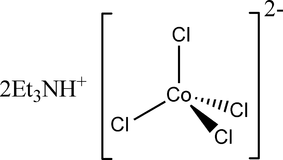
The complex salt $CoCl_{ 4 }^{ 2- }$ has a tetrahedral structure. How many d-electrons are on the cobalt?
Answer
486k+ views
Hint: First just try to find the hybridization of the complex and then you can just calculate the electrons present. But keep in mind that if there is some charge left on the metal atom you have to satisfy that also. Now, you can easily solve this question.
Complete step by step answer:
First, we know that it is a tetrahedral complex so there is only one possibility of the hybridization of the molecule. That would be $sp^{ 3 }$.
In $sp^{ 3 }$ hybridization, we need one s and three p hybrid orbitals. These should be degenerate.
You should know that here $Cl^{ - }$ is a weak ligand, hence pairing is not possible.
Co has the atomic number 27, which means it has $3d^{ 7 }4s^{ 2 }$ electronic configuration.
In $CoCl_{ 4 }^{ 2- }$ complex, if we calculate the oxidation number of copper, it would be-
x + 4(-1) = -2
x = +2
So, here copper is in +2 oxidation state. That means it loses 2 electrons from 4s orbital.
After losing 2 electrons it is left with only 7 electrons and those are located in 3d orbitals.

Therefore we can say that there are 7 d-electrons on the cobalt in complex salt $CoCl_{ 4 }^{ 2- }$.
Note: The geometry of $sp^{ 3 }$ Hybridization:
$sp^{ 3 }$ hybridized orbitals repel each other and they are directed to four corners of a regular tetrahedron. The angle between them is 109.5 degrees and the geometry of the molecule is tetrahedral (non-planar). This type of hybridization is also known as tetrahedral hybridization.
Complete step by step answer:
First, we know that it is a tetrahedral complex so there is only one possibility of the hybridization of the molecule. That would be $sp^{ 3 }$.
In $sp^{ 3 }$ hybridization, we need one s and three p hybrid orbitals. These should be degenerate.
You should know that here $Cl^{ - }$ is a weak ligand, hence pairing is not possible.
Co has the atomic number 27, which means it has $3d^{ 7 }4s^{ 2 }$ electronic configuration.
In $CoCl_{ 4 }^{ 2- }$ complex, if we calculate the oxidation number of copper, it would be-
x + 4(-1) = -2
x = +2
So, here copper is in +2 oxidation state. That means it loses 2 electrons from 4s orbital.
After losing 2 electrons it is left with only 7 electrons and those are located in 3d orbitals.

Therefore we can say that there are 7 d-electrons on the cobalt in complex salt $CoCl_{ 4 }^{ 2- }$.
Note: The geometry of $sp^{ 3 }$ Hybridization:
$sp^{ 3 }$ hybridized orbitals repel each other and they are directed to four corners of a regular tetrahedron. The angle between them is 109.5 degrees and the geometry of the molecule is tetrahedral (non-planar). This type of hybridization is also known as tetrahedral hybridization.
Recently Updated Pages
Can anyone list 10 advantages and disadvantages of friction

What are the Components of Financial System?

How do you arrange NH4 + BF3 H2O C2H2 in increasing class 11 chemistry CBSE

Is H mCT and q mCT the same thing If so which is more class 11 chemistry CBSE

What are the possible quantum number for the last outermost class 11 chemistry CBSE

Is C2 paramagnetic or diamagnetic class 11 chemistry CBSE

Trending doubts
The correct order of melting point of 14th group elements class 11 chemistry CBSE

One Metric ton is equal to kg A 10000 B 1000 C 100 class 11 physics CBSE

What is the specific heat capacity of ice water and class 11 physics CBSE

State the laws of reflection of light

Proton was discovered by A Thomson B Rutherford C Chadwick class 11 chemistry CBSE

Why does niobium have a d4s1 electron configuration class 11 chemistry CBSE




